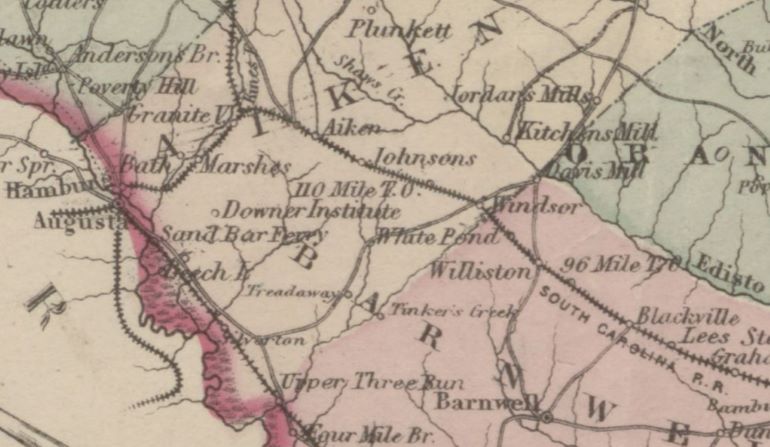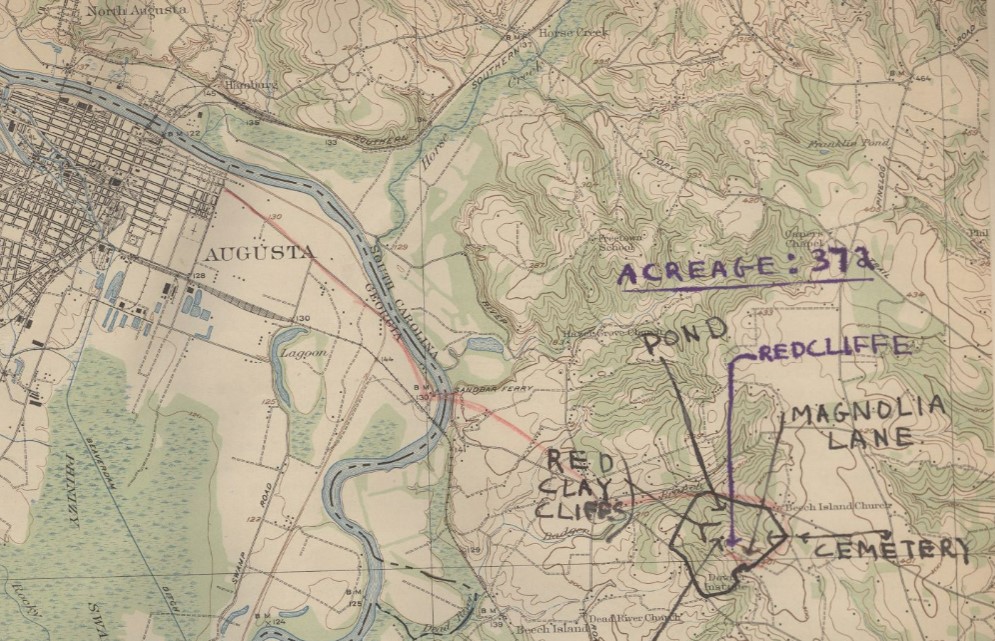
Aiken County, S.C.
Sandhills, Thoroughbreds, & Cotton Mills




Welcome to Aiken County, South Carolina
Founded March 10, 1871
We are so please you dropped in to check us out. We have been 'doing' genealogy
for more than 30 years! You'd think after all that time, we'd have all the answers!
Not even close. We are always looking for new cousins and related families.
Please let us know how you fit into our puzzle.
We do not create history. We share the pieces we discover. We welcome your discoveries as we create vivid colorful images of the past.
Visit us on social media - Aiken & Barnwell County GenWeb.
Sandhills, Thoroughbreds, & Cotton Mills
 A river of sand
called “Sand River” runs through Hitchcock Woods from the Aiken city limits through Horse Creek Valley,
which can become quick sand after a heavy rain. It is the source of Native American legends and one of the most beautiful and unusual features of Hitchcock Woods. It is not uncommon for the rains to wash the flow of sand leaving
behind discoveries of Old Edgefield Pottery and other treasures that bear witness to the inhabitants of the area more than 250 year ago. South Carolina
is known for three distinct types of folk-art: Sweetgrass basketry, Catawba pottery, and Edgefield pottery, largely produced by Dave, a literate slave.
This area of discovery
is significant as Aiken County was created in 1871 from parts of Barnwell, Edgefield, Lexington, Orangeburg counties. When searching for early records you will want to include these adjoining counties in your search. Records from the early Aiken County courthouse
are not available. The original courthouse built in 1872 with funds from wealthy mill owner William Gregg, Jr., burned in January 1970. The current building was built in 1881.
A river of sand
called “Sand River” runs through Hitchcock Woods from the Aiken city limits through Horse Creek Valley,
which can become quick sand after a heavy rain. It is the source of Native American legends and one of the most beautiful and unusual features of Hitchcock Woods. It is not uncommon for the rains to wash the flow of sand leaving
behind discoveries of Old Edgefield Pottery and other treasures that bear witness to the inhabitants of the area more than 250 year ago. South Carolina
is known for three distinct types of folk-art: Sweetgrass basketry, Catawba pottery, and Edgefield pottery, largely produced by Dave, a literate slave.
This area of discovery
is significant as Aiken County was created in 1871 from parts of Barnwell, Edgefield, Lexington, Orangeburg counties. When searching for early records you will want to include these adjoining counties in your search. Records from the early Aiken County courthouse
are not available. The original courthouse built in 1872 with funds from wealthy mill owner William Gregg, Jr., burned in January 1970. The current building was built in 1881.
Aiken is famous for breeding thoroughbreds which began with the Aiken Steeplechase Association founded in 1930. The Aiken Trials are the first leg of Aiken's Triple Crown events which began in 1942.
New York financier William C. Whitney, who brought polo to the city in the late nineteenth century, established the Aiken Winter Colony for the Northern elite who traveled south to play polo and buy and sell thoroughbreds.
When searching for ancestors, remember many of the people buried in Aiken have roots up North and you will want to expand your search as Aiken experienced a population explosion in the early 1940's.
Southern cotton mill villages have been a deeply rooted feature of this area for two centuries. In 1845 William Gregg built the first cotton mill at the head waters of Horse Creek establishing the village of Graniteville.
The cotton mill is a southern born industry which is the roots of the people who lived out their lives as mill workers. The cotton mills provided opportunity for steady wages that could not could be found on farms. The idea of being able to provide for their families meant prosperity and a new way of life
for those who came to the area. What began with Graniteville Mill in 1845 soon found those same waters of Horse Creek powering Warrenville Mill, Langley Mill, Bath Mill, Seminole Mill, and the Clearwater Finishing Plant until the last mill closed in the mid 1980's.
That booming new way of life also found itself in a new form of class and social discrimintation which writer Erskine Caldwell captured in his novels "God's Little Acre" and "Tobacco Road".
Cormac McCarthy's play, The Gardener's Son, is based on the 1876 murder at Graniteville Mill.
From murder to threats of unionization, the 1886 mill strikes would see wealthy mill owners shut down the mills preventing families from earning wages until they gave up on the idea and went back to work for low wages and poor working conditions. The people of Horse Creek Valley endured it all.
South Carolina began issuing death certificates in January 1915. It is in the early records that is found documentation of the various lung diseases caused by inhaling decades of cotton fibers before OSHA established safe working conditions.
The last operating cotton mill in Horse Creek Valley closed in 1985.
With more than a century of class rivalries between the Aiken wealthy elite and their derrogatory references to the working class of the Valley as "mill rats",
it is those "mill rats" who worked and sustained the area economy making it possible for the wealthy families such as the Rockefellers, Vanderbilts, and Astors, who came to spend money in the resort towns of Aiken and North Augusta, to enjoy their eleveated style of living.
The men of the Valley worked in the mills and it was their wives and daughters who cooked, cleaned, took in washing, and tended the children of the wealthy Northerners.
During this time of flourishing wealth, North Augusta was a hot spot on the “Chitlin’ Circuit” where Ella Fitzgerald,
Jimmie Lunceford, Cab Calloway and his Cotton Club Orchestra, Louis Armstrong, and Dizzy Gillespie frequently played Jazz and sang the blues. It was Bing Crosby, Fred Astaire, and other Hollywood figures who came to listen and be entertained between rounds of golf and horse track races.
Between the two cities of Aiken and North Augusta is where you will find the working class people in the cemeteries along Hwy 1 and Hwy 421 east of the City of Aiken.
Image credit: Sand River postcard. USC Digital Libraries Collection. Copyright not evaluated by USC.
Savannah River Plant
 The Savannah River Site (SRS)
was constructed during the early 1950s to produce the basic materials used in the fabrication of nuclear weapons during the cold war era.
SRS covers 310 square miles of land in Aiken County boarding Barnwell County and the Savannah River. Small towns,
villages, and people were displaced to make way for the site.
The SRS Museum sugarcoats the removal of 6,000 people and nearly one thousand cemeteries to make way for what was referred to then as the 'bomb plant'. It was not a happy exidus.
The Savannah River Site (SRS)
was constructed during the early 1950s to produce the basic materials used in the fabrication of nuclear weapons during the cold war era.
SRS covers 310 square miles of land in Aiken County boarding Barnwell County and the Savannah River. Small towns,
villages, and people were displaced to make way for the site.
The SRS Museum sugarcoats the removal of 6,000 people and nearly one thousand cemeteries to make way for what was referred to then as the 'bomb plant'. It was not a happy exidus.
SRS and the USC Archealogy Department have partnered to share the two volumes of documentation that records the removal of cemeteries from the area. The work is not without errors. Download the two volumes to search at your leisure. In the records you will find photos of homes, buildings, and cemetery removals. Some of the locals moved to other areas such as "New" Ellenton, Jackson and Hawthorne. Some families cut their losses and took the money being paid for their homes and land leaving the area in search of a new future and a willingness to start over. For many who were forced to sell and move away from ancestral lands it is still a painful subject. For the earliest workers who suffered medical disabilities due to exposure to various forms of radiation, they are the beneficiaries to healthcare and disability compensation by the Federal government.
Today, the site promotes an evironment of ecology and preservation that represents a legacy of the national defense system. This historical accounting of the separation is filled with photos and maps of the area. Those looking to see the ancestral homesites and landmarks for themselves can register for site tours. You must be a US Citizen and have government issued identification to be admitted.
There is an enormous amount of genealogical information in the records I have linked to above. It is a huge task that needs many volunteers to extract the data. If you would like to help, please contact me.
Read more about Aiken County on Wikipedia
Quick Links:
Contact Us:
- Angie Rapids, Aiken County Coordinator
- Jeff Kemp, State Coordinator
Webmaster Message
We do our best to document all resources. If you find an error, please let us know!
Thank you!















